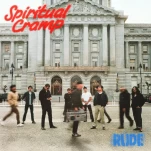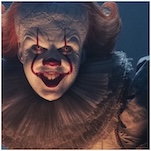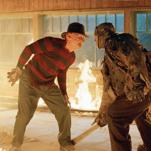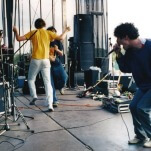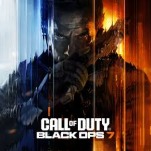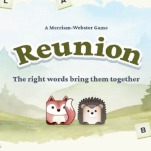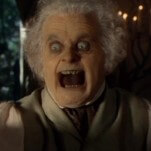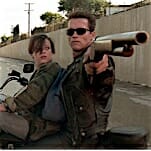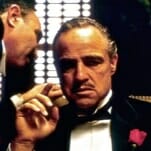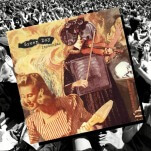Fight Night: Freddy vs. Jason Delivered on its Title
And absolutely nothing else.
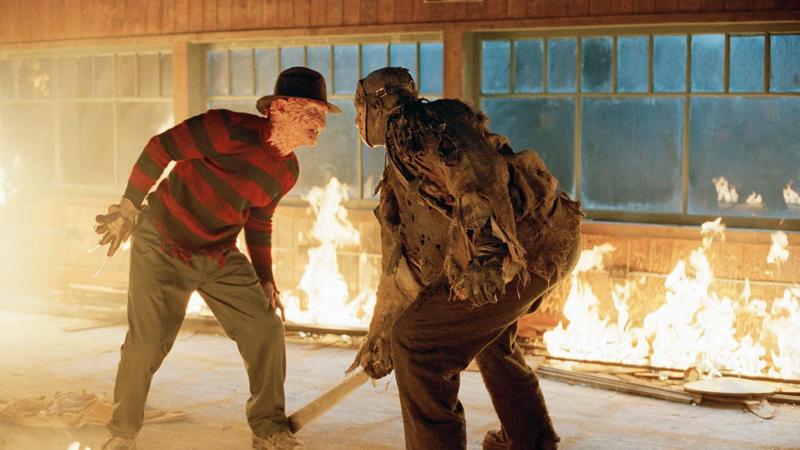
Conflict is the most basic building block of story, and a fight is the most simple conflict there is: Two people come to blows, and one must triumph over the other. Fight Night is a regular column in which Ken Lowe revisits some of cinema history’s most momentous, spectacular, and inventive fight scenes, from the brutally simple to the devilishly intricate. Check back here for more entries.
I was at a terminal once in Cali, Colombia, waiting for my shuttle bus back to my apartment block to muscle its way out of the dedicated bus lanes and into regular traffic at the height of after-work rush hour. Nothing was moving, except the two guys outside the window engaged in a fistfight. I didn’t see how it started, but I heard hooting and hollering and turned to see these two throwing hands. Folks were less interested in intervening than they were in capturing video of the affair. Somebody eventually pulled one of the guys off when his opponent went down and he started kicking the dude.
The story behind this fight is one that I, and none of the other cheering bystanders, will ever know. For those watching, it really didn’t matter—it was a momentary distraction from their day. But it was pretty gnarly, as random street fights go. Surely people told the folks at home about it.
In one sense, Freddy vs. Jason is exactly that kind of fight: a momentary distraction that is nonetheless remarkable because it is also FREDDY versus JASON, two of the legends of the slasher subgenre of horror. In the case of Freddy Krueger of A Nightmare on Elm Street, that legend was large enough to essentially make New Line Cinema a going concern. The Friday the 13th movies also loomed impossibly large in the minds of slasher fans. If these two are going to throw down in a movie, how can you not want to watch it?
Fight Night is here for the creepily practical, the absolutely legendary, and the patently absurd fights. And, God help me, it is also here for shameless spectacle. We can’t not watch Freddy vs. Jason.
The Film
The town of Springwood, Ohio has a deadly, desperate secret it keeps from its youth. The serial killer Freddy Krueger (Robert Englund, the absolute legend) has been defeated and languishes in hell without the sweet, delicious fear that enables him to haunt the nightmares of the town’s children. Krueger decides to manipulate another to help resurrect his legend in the minds of Springwood’s young people, reviving the killer Jason Voorhees (Ken Kirzinger, rather than veteran Kane Hodder, much to the annoyance of fans). By impersonating the immortal killer’s mother and setting him loose on Springwood, Freddy reasons the killings will be chalked up to himself instead, growing his legend and resurrecting him.
The movie then pivots to several young people. It has been a while since I’ve steeped myself in the (convoluted and often contradictory) lore of the Nightmare on Elm Street series, so I promise I looked very hard to see if any of these characters have been in the movie series before. I find no evidence that they have, and yet they are already in the midst of drama that seems like it came from a previous movie: Two high schoolers are already in an oppressive mental institution that drugs and lies to them, the movie’s final girl, Lori (Monica Keena) is struggling with finding the truth about her mother’s death and whether her father is hiding it from her, and the town’s sheriff resolutely refuses to clue in his newest deputy on the actual truth of Freddy Krueger—we are supposed to already know that any mention of him or fear of him at all (among kids, not adults!) serves to summon him back from hell.
I don’t want to get into the teen characters too much: You may recognize Kelly Rowland, Christopher Rodriguez Marquette, Brendan Fletcher, and Jason Ritter from stuff they were all just recently in! I’m glad they’ve gone on to have respectable careers, because their roles are utterly thankless in this, the most 2003 of 2003 movies (not a compliment). The teens are horny, foul-mouthed, one-dimensional, and given garbage lines to work with. Once the killings start, they do not so much deduce Freddy’s plan as guess it out of thin air. At one point Lori points out that Freddy was killed with fire and Jason with water and maybe this means something—it does not, and never comes up again. In a bid to diminish Freddy’s fear over her, Rowland’s character calls him a gay slur—though, he did just use an off-color term for a Black person to refer to her. After finishing this movie, I discovered that somehow my college degrees, driver’s license, and status as a legal adult had all been revoked.
Fortunately, it all moves fast. Jason goes a-machete-ing, and Freddy does get some of the credit. But then the kids get wise to Jason’s legend, and Freddy realizes he needs to rein in his rabid dog before Jason steals his thunder. The last reel of the film features two face-offs between the ur-slashers—one in Freddy’s nightmare realm, and the other back in the waking world at good ol’ Camp Crystal Lake.
The Fight
As Jason stalks the teens in the last part of the film, Freddy shows up to kill him—injecting him with industrial-strength soporifics and then plunging into his mind to do what he does best, which is kill people in nightmares. What follows is the first part of their exchange, a deeply silly slapstick fight in Freddy’s nightmare hell world.
Yes. Jason makes pinball machine noises as Freddy throws him around the arena.
Back in the waking world, the teens have by now reasoned that they are better off siding with Jason (sure), who they believe will just leave them alone if they make sure to dump him back at his old haunting ground in Crystal Lake and then just never bug him again (maybe). Freddy did also kill Lori’s mother, so it’s kinda personal. The teens’ plan mostly makes sense: Lure Freddy into Lori’s dreams, wake her up so he’s bounced back into reality on Jason’s home turf, then let the two slug it out. It’s time for a road trip to Camp Blood!
We must, of course, reckon with canonical distance now. Because the teens are driving the insensate and nightmare-besieged Jason and Lori from Elm Street (that’s in Ohio!) to Camp Crystal Lake (that’s in New Jersey)! Wearing the guise of Jason’s mother, Freddy originally sicced Jason on Springwood by telling him to “go to Elm Street,” so it’s really lucky that Jason knew that his mother meant the specific one about a seven- or eight-hour drive away! I’m sorry that this matters to me this much! But they arrive, and we finally get the fight we were promised.
The horror—indeed, the whole point—of characters like Freddy Krueger and Jason Voorhees is that they can’t be killed in any conventional sense. Shoot them, stab them, run them over with cars, burn them alive, sink them in a lake—and they’ll shake it off in time for the next movie. Freddy vs. Jason accepts this premise and then commits to a fight that has fun with it. For completionists, it may almost be worth the price of admission. Because, once the most 2003 teens to ever 2003 finally shut their damn mouths, the two get to fighting.
Every blow from Jason’s machete or Kruger’s claws draws fountains of blood from the combatants, and the stuntmen and effects guys are not afraid to utterly demolish parts of the set to sell the fiction. The movie’s favorite trick has been to hurl people into walls, and it now gets to do so with its two heavies.
The first long stretch of the fight features Freddy beating down on Jason—he hits him with pressured gas tanks, spears him with rebar, and finally just cuts off his fingers and gouges out his eyes. Both fighters are just bleeding everywhere by the end of it, all while the film’s score is shredding on an electric guitar. It’s deeply stupid, but deeply fun.
The teens interrupt it, of course—I do so wish they’d go away already. Lori soaks the dock in gasoline and then lights the entire movie on fire, and then beheads Freddy with Jason’s machete. The nightmare is over—or is it? The next morning, we see Jason rise from the lake clutching Freddy’s noggin, the presumptive victor, but naturally Freddy has his typical last-minute tease of immortality that typifies so many Nightmare on Elm Street endings. Jason arguably wins the day, but you can’t keep the dream king down.
The Fallout
This is usually the part of a Fight Night column where I wax about the long tail of a particular entry. I shall not do so here, because there isn’t one: After their obligatory late ’00s reboots, neither character experienced a revival. Usually these fights start something: Freddy vs. Jason more or less ended something. We must ask what, and why.
The 1990s and 2000s, and Nightmare creator Wes Craven in particular, have much to answer for when it comes to what happened to horror cinema. (Craven gets a writing credit on this film, but Ronny Yu directed.) There are some who have called out more recent horror films for not “being scary” or otherwise being uncomfortable in their own skin as pure horror films. Every time I hear this from somebody, I would like to show them Scream or I Know What You Did Last Summer, and, inevitably, the chain of events that led to Freddy vs. Jason. There isn’t anything scary, disturbing, or even cerebral about any of this.
By 2003, both Freddy Krueger and Jason Voorhees had been more or less put to bed for a decade: Krueger in 1991’s Freddy’s Dead: The Final Nightmare and Jason in Jason Goes to Hell: The Final Friday. You notice that “FINAL!” in both of those. (They did both come back before even appearing here, though neither in a way that respected continuity: Jason X is set 400 years in the future and Wes Craven’s New Nightmare is a kind of meta-textual reboot.)
The third child here (not invited to this rumble) is Michael Myers of Halloween fame, and as I wrote once upon a time, he’s motivated by the same influences that have been made so explicit in sendups like Behind the Mask: The Rise of Leslie Vernon or Cabin the Woods, and even in Wes Craven’s own Scream. Slasher movies are mostly about punishing randy teenagers, and we were already hanging a Joss Whedon-sized lampshade on that in 1996.
In 2003, all subtext is gone, and has become text: These kids are banging, therefore they are gonna die. Something rote is by definition not all that scary. Freddy vs. Jason is not just rote, but cynical.
If there’s anything to like here, though, it is in that wet and practical fight between its two eponymous heavies. Englund is doing his absolute damnedest to be a sneering baddie. Kirzinger doesn’t have the hulking presence of Hodder, but he and the costumers and especially the effects team do a good job of making him seem massive and unstoppable. For the five or so minutes that they tangle—the last time this iteration of these characters will ever be on the screen, let alone share it—it really is something to tell the folks at home about.
Join us next month for a final, gory battle of indestructible katanas and destined warriors as Fight Night revisits Ryuhei Kitamura’s Versus.
Kenneth Lowe is a regular contributor to Paste Movies. You can follow him on Bluesky @illusiveken.bsky.social, and buy his fantasy novel here.
